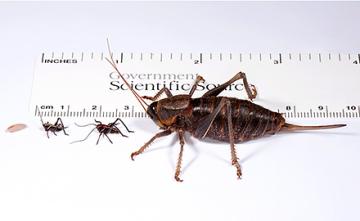Mormon Crickets: A Long-horned Nuisance

Shown left to right are four of the Mormon crickets’ life stages: egg, first instar nymph, third instar nymph, and adult female. (Photo by Stephen Ausmus).
Like grasshoppers, Mormon crickets are a perennial pest of crops and rangeland in the western United States. Recognizing the economic impact these insects have on America’s farmers and ranchers and on the nation’s food supply, the Mormon cricket was officially designated a pest by Congress back in the 19th Century, and they remain a significant problem for farmers and ranchers today.
Current control strategies are heavily reliant on broad spectrum pesticides and are often expensive, insufficient, and/or negatively impact the ecosystem. To learn how to better control these pests using eco-friendly alternatives, ARS researchers must first understand the role Mormon crickets play in the rangeland ecosystem and the climatic and ecological triggers that contribute to large outbreaks of these pests. Understanding the triggers can help predict future outbreaks, allowing farmers, ranchers, and land managers to address them earlier and optimize control efforts.
Scientists at the Northern Plains Agricultural Research Laboratory in Sidney, MT, are exploring how Mormon crickets behave and interact in different environments, conducting several experiments focusing on delayed egg development and the role it may play in population outbreaks. For example, when located in highlands, the eggs can spend many generations in diapause (not hatching) underground, possibly because of the lower temperatures and higher moisture levels. In lowlands where it’s hotter and drier, Mormon crickets hatch and develop more quickly, but those same conditions can also cause significant egg losses due to the drought and heat. Knowing the environmental triggers for egg development and hatch, along with knowing the sources of egg mortality, can help predict when rapid population increases may occur and when those increases may pose an economic threat to farmers and ranchers.
By studying Mormon cricket’s relationship to their environment and determining future trends, researchers will have the necessary knowledge to develop prevention techniques and other management tactics to reduce economic impacts to agricultural and natural ecosystems. One consequence of discovering that Mormon crickets can bank their eggs for multiple years is that no chemical is registered for application to kill Mormon cricket eggs in the soil. As a result, novel techniques for discovering where eggs are banked and reducing the number of banked eggs are needed.
Among those new techniques are efforts to augment existing natural biocontrols.
“There is a species of wasp that will attack the eggs underground and kill them,” explained Robert Srygley, a research ecologist at the Pest Management Research Center in Sidney, MT. “It inserts its own eggs into the Mormon cricket egg. The wasp larvae hatches and feeds on the contents, and then pupates inside the egg. The adult wasps then emerge through a tiny hole in the egg and the cycle begins anew.”
Digger wasps are another natural biocontrol under study. According to Srygley, this wasp attacks the Mormon cricket adults, with a preference for attacking female Mormon crickets rather than males, an effective choice for limiting population expansion. Digger wasps dig a burrow underground and will then attack a Mormon cricket, paralyzing it with its sting. Afterwards, it will drag the paralyzed insect into its burrow and lay an egg on it. When the egg hatches the larva will feed on the cricket, eventually causing its death. Additional biocontrol agents in nature include other parasitic wasps and flies, rodents, game birds, hawks, and seagulls.
ARS scientists must find the answers as to why the eggs can remain in diapause for such extended periods, making it difficult to provide a consistent supply. Research to shorten that time period is ongoing. This research is allowing ARS scientists learn more about Mormon crickets’ ecological interactions in order to develop new and improved management practices and help growers and land managers protect crops and enhance natural areas that provide biodiversity and aesthetics. — By Olga Vicente, ARS Office of Communications
You May Also Like:

